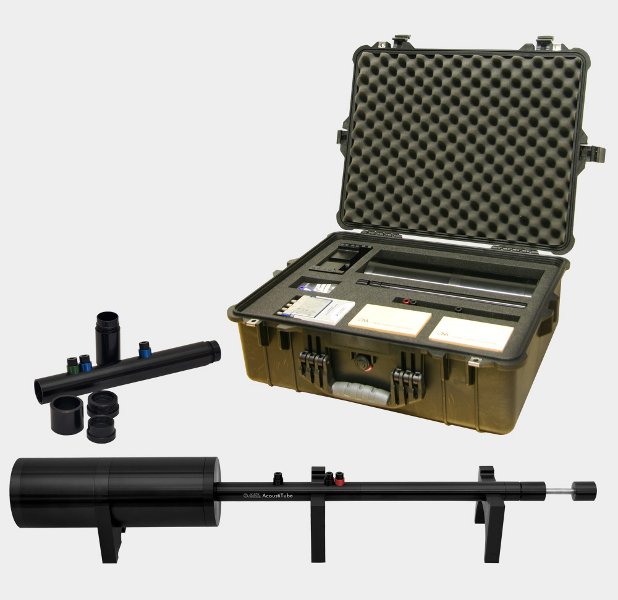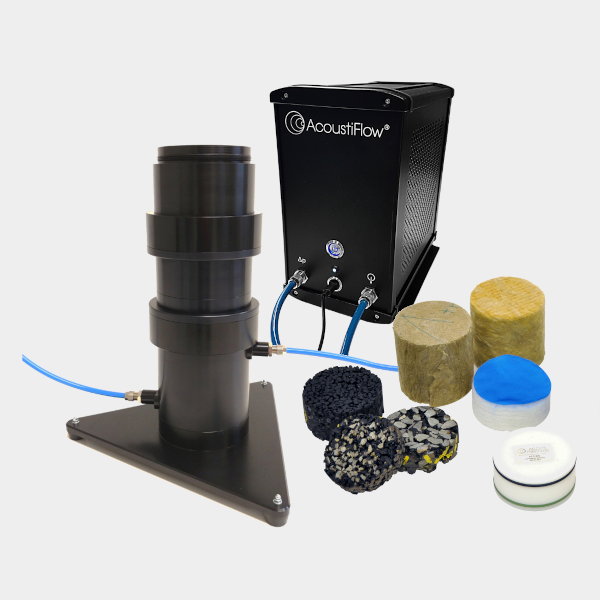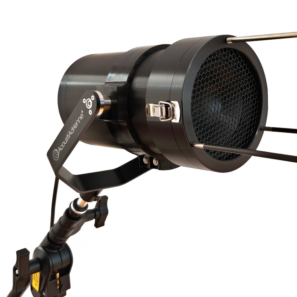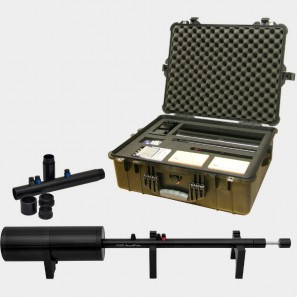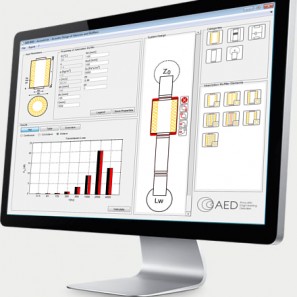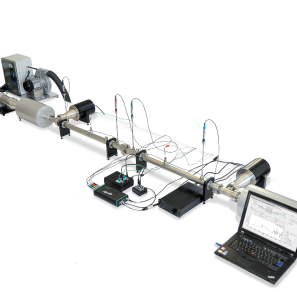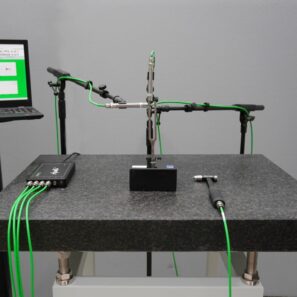Principle of impedance tube (Kundt’s tube)
In the impedance tube a plane sound wave is generated and sent against a sound absorbing specimen in front of a reverberant termination. The resulting sound pressure is measured by using two microphones in front of the material sample. The sound absorption coefficient of the material is determined by evaluating the incoming and reflected sound energy.
Specimen holders
Type I
- Application: determination of sound absorption coefficient of materials in the laboratory according to DIN EN ISO 10534-2, ASTM E1050 and VW Test specification PV 8223
- Specimens:
- cylindrical specimens with a diameter of 15 mm, 30 mm, 40 mm or 100 mm
- cuboid specimens with height x width of 50 mm x 50 mm
- Method: prepared cylindrical or cuboid specimens of variable thickness are mounted and sealed into the specimen holder, which can be continuously positioned and adjusted
Type II
- Application: determination of sound absorption coefficient in situ according to DIN ISO 13472-2 (sound absorption coefficient < 0,15)
- Specimens: road surfaces and plates of specimens with a dimension of at least 300 mm x 300 mm
- Method: adapter for tight attachment of impedance tube to the surface of the specimen
Software
The measurement system AcoustiTube® is supported by the analysis software AcoustiStudio – Module Sound Absorption.
- determination of material properties as a function of frequency
- averaging of results of various material samples, frequency ranges and impedance tubes
- simple management and comparability of results by application of database
The analysis software AcoustiStudio allows the application of impedance tubes of arbitrary geometry.
Quick Setup Guide of impedance tube AcoustiTube®
To Quick Setup Guide for impedance tube AcoustiTube on YouTube®.
Extension of impedance tube to transmission tube
An extension of the impedance tube AcoustiTube® to the transmission tube with analysis software AcoustiStudio – Module Sound Transmission allows the determination of the characteristic absorber values (wave number and characteristic impedance), the transmission coefficient and the sound insulation (transmission loss) by applying the Two-Load Method with 4 microphones according to ASTM E2611 (Transmission Matrix Method).
On such basis, the insertion loss of mufflers (see software for acoustic design of mufflers AcoustiCalc® Silencer) and the diffuse sound absorption coefficient (see software for acoustic design of sound absorbers AcoustiCalc® Absorber, comparison to measurements in the reverberation chamber according to DIN EN ISO 354, especially rated sound absorption coefficient of the material according to DIN EN ISO 11654) can be computed directly (see overview measuring systems vs. analysis software).
Optional extensions of the transmission tube also allow the alternative application of the Two-Source Method with 4 microphones or the Two-Load Method with 3 microphones to measure the characteristic absorber values and the transmission loss. Furthermore, it is possible the determine the transmission loss of open-cell material specimens as well as silencers and mufflers according to DIN EN ISO 11820.^
Compression specimen holder for impedance tube
As of now, a novel compression specimen holder extends the application range of the impedance tube, transmission tube and the airflow resistivity meter AcoustiFlow®.
The specimen holder can be adjusted nearly continuously. Therefore, it allows the defined compression of cylindrical specimens and fills to measure the sound absorption coefficient, characteristic absorber values, transmission loss and the airflow resistance. Also, thin fabrics, granular fills as well as multi-layer systems can be installed with control.
Technical Data
Impedance tube
- Type I for cylindrical specimens
- Inner diameter: 40 mm
- Frequency range: 100 Hz – 4.950 Hz
- Type II for cylindrical specimens
- Inner diameter: 100 mm
- Frequency range: 50 Hz – 2.000 Hz
- Type III for cylindrical specimens
- Inner diameter: 30 mm
- Frequency range: 150 Hz – 6.600 Hz
- Type IV for cylindrical specimens
- Inner diameter: 15 mm
- Frequency range: 150 Hz – 10.200 Hz
- Type V for cuboid specimens
- Internal dimensions height x width: 50 mm x 50 mm
- Frequency range: 90 Hz – 3.400 Hz
- Thickness of specimen
- Impedance tube: 260 mm
- Transmission tube: 80 mm
- Compression specimen holder: 360 mm
Microphones
- Type: 1/4″, BNC (female), class 1
- Frequency range: 20 Hz – 20 kHz
Data acquisition
- 2/4 simultaneously sampled analog input channels, BNC, IEPE-conditioning
- compatible to MATLAB* and LabVIEW**
Requirements
- Personal computer: Windows 7 / 8 / 10, 2x USB-interface
- Power supply: 230 V (AC), 50 Hz
- Ambient air temperature: 5 °C – 60 °C
* MATLAB is a registered trademark of The Math Works, Inc.
** LabVIEW is a registered trademark of the National Instruments Corporation
